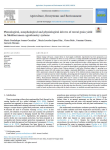Arenas-Corraliza M.G., López-Díaz M.L., Rolo V., Cáceres Y., Moreno G. (2022). Phenological, morphological and physiological drivers of cereal grain yield in Mediterranean agroforestry systems. Agriculture, Ecosystems & Environment, 01/12/2022, vol. 340, p. 1-11.
https://doi.org/10.1016/j.agee.2022.108158
https://doi.org/10.1016/j.agee.2022.108158
| Titre : | Phenological, morphological and physiological drivers of cereal grain yield in Mediterranean agroforestry systems (2022) |
| Auteurs : | M.G. Arenas-Corraliza ; M.L. López-Díaz ; V. Rolo ; Y. Cáceres ; G. Moreno |
| Type de document : | Article |
| Dans : | Agriculture, Ecosystems & Environment (vol. 340, 1 December 2022) |
| Article en page(s) : | p. 1-11 |
| Langues : | Anglais |
| Langues du résumé : | Anglais |
| Catégories : |
Catégories principales 06 - AGRICULTURE. FORÊTS. PÊCHES ; 6.4 - Production Agricole. Système de ProductionThésaurus IAMM SYSTEME DE PRODUCTION ; AGROFORESTERIE ; CEREALE ; CEREALICULTURE ; VARIETE ; CHOIX DES ESPECES ; REGION MEDITERRANEENNE |
| Résumé : | Climate change will pose a major threat to food supply worldwide. Agroforestry has been proposed as an effective approach to minimize its effects on crops. However, to design sustainable and productive agroforestry systems, net responses of crops to trees need to be clarified, particularly in regions where competitive interactions will outweigh facilitative ones. The study of plant traits has become a useful approach to select best-adapted plants, yet the sensitivity of yield components to agroforestry and their relationship with plant traits needs investigation. In this experiment, we assess the phenological, morphological and physiological responses of shade-adapted cultivars of winter wheat (Triticum aestivum L.) and barley (Hordeum vulgare L.), growing in an agroforestry system (AF) with walnut trees (Juglans x intermedia Mj209xRa), as compared to cereal monocrops (MC). Agroforestry reduced the light intercepted by crops by 58 %, buffered extreme temperatures at the crop canopy level and increased air relative humidity, advancing plant development for wheat and barley. Major tree effects on crops were observed after walnut budburst. Under trees, crops increased the relative water content (RWC), Photochemical Reflectance Index (PRI) and P content of both wheat and barley leaves, increased Normalized Difference Vegetation Index (NDVI) of barley leaves, and reduced leaf mass area (LMA) in wheat and cell membrane damage in both species. In agroforestry, crops also reduced plant growth, leaf area (LA), leaf area index (LAI) and grain yield in both wheat and barley. Drivers of grain yield differed among agroforestry and open conditions in both species, showing for the first time that the selection of cereal cultivars for specific conditions could be based on plant traits, along with the shade tolerance, to establish successful agroforestry systems. |
| Cote : | Réservé lecteur CIHEAM |
| URL / DOI : | https://doi.org/10.1016/j.agee.2022.108158 |







